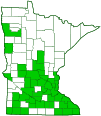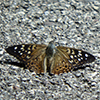hackberry emperor
(Asterocampa celtis)
Conservation • Description • Habitat • Ecology • Distribution • Taxonomy
|
|
|||||||||||||
Description |
Hackberry emperor is a medium-sized brushfooted butterfly, with a wingspan of 2″ to 2⅞″. Females are usually much larger than males and have broader wings. The coloration of the wings is geographically variable. Within the state both dark forms and light forms are found. The upperside of the forewing is usually grayish-brown (dark form) near the base, fading to orangish brown toward the center of the wing, and black near the tip. On the pale form the base color is brownish-yellow. The central area of the forewing (cell) has a single black bar and two separated black spots. There is a single submarginal eyespot with a black pupil surrounded by orange. The pupil may have a small blue center. In the black area near the tip there is a jagged row of seven cream-colored subapical spots and a jagged row of four white submarginal spots. The hindwing is orangish-brown. The basal portion of the hindwing is covered with long hairs. The margin is orangish with dark veins and a straight black border. There is a submarginal row of black chevrons and a postmedial band of black spots. The postmedial spots may have small blue centers. The underside of both wings light brown and gray. The black spots from the upperside become on the underside yellow-ringed black eyespots with white centers. The caterpillar is pale green and up to 1½″ long. It is densely covered with short hairlike structures (setae). Each seta has an enlarged white base, giving the caterpillar a finely spotted appearance. A narrow subdorsal white stripe extends on each side from the head to the last abdominal segment. The neck is narrow. There are two antler-like horns attached to the upper (dorsal) surface of the head, and two spine-like projections extending from the last abdominal segment. Mature caterpillars of the first brood are found in May and June, of the second brood in July and August. |
Size |
1⅜″ to 2½″ |
Similar Species |
Tawny emperor (Asterocampa clyton) is lighter and more colorful. The wing uppersides are brownish orange. The forewing does not have white spots in the apical area and does not have a black eyespot in the submarginal area. The forewing cell has two unbroken bars and no separate spots. |
Habitat |
Edges and openings of moist deciduous woodlands, streams, parks—virtually any site with more than one northern hackberry tree |
Ecology |
Season |
Two broods: early June to mid-July and late July to early September |
Behavior |
Adults perch head down of tree trunks and the sides of buildings. Their flight is fast and erratic. Males are attracted to bright colors, and can be lured with red and white paper. Though common within its range it is sometimes overlooked due to its tendency to fly around the tops of trees. |
Life Cycle |
The male will perch on a tall object waiting for a passing female. After mating the female will lay clusters of eggs on the leaves of a host tree. When the eggs hatch the larvae feed individually, not communally. The second brood overwinters as larvae. |
Larva Hosts |
In Minnesota, leaves of northern hackberryand possibly elm. Some sources state that the larvae feed communally. According to Caterpillars of Eastern North America (Wagner, 2005), caterpillars of tawny emperor “feed communally through the third instar”, but the hackberry emperor does not feed communally. |
Adult Food |
Tree sap; rotting fruit; animal dung, urine, sweat, and carrion; and occasionally flower nectar of staghorn sumac, red clover, common milkweed, and yellow sweet clover. |
Distribution |
||
|
Sources 7, 21, 24, 27, 29, 30, 75, 82, 83. Biodiversity occurrence data published by: Minnesota Biodiversity Atlas (accessed through the Minnesota Biodiversity Atlas Portal, bellatlas.umn.edu, 7/21/2025). |
|
| 7/21/2025 | ||
Occurrence |
||
Locally common in the southern half of Minnesota, occasional visitor further north |
||
Taxonomy |
|
Order |
|
Superfamily |
Papilionoidea (Butterflies) |
Family |
Nymphalidae (Brush-footed Butterflies) |
Subfamily |
Apaturinae (emperors) |
Genus |
Asterocampa (hackberry butterflies) |
Subordinate Taxa |
|
hackberry emperor (Asterocampa celtis celtis) hackberry emperor (Asterocampa celtis reinthali) hackberry emperor (Asterocampa celtis alba) hackberry emperor (Asterocampa celtis inornata) hackberry emperor (Asterocampa celtis montis) Texas hackberry emperor (Asterocampa celtis antonia) |
|
Synonyms |
|
Apatura celtis |
|
Common Names |
|
hackberry emperor |
|
Glossary
Cell
In Lepidoptera: the large central area of the wing surrounded by veins.
Instar
The developmental stage of arthropods between each molt; in insects, the developmental stage of the larvae or nymph.
Seta
A usually rigid bristle- or hair-like outgrowth on butterflies and moths used to sense touch. Plural: setae.
Visitor Photos |
||
Share your photo of this insect. |
||
This button not working for you? |
||
Greg Watson |
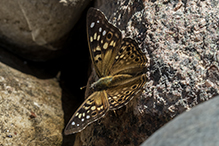 |
Plenty of these flying around today, even landing on me. They seemed to be probing for salts on me as well as on rocks. |
John Shier |
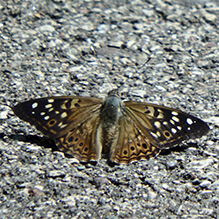 |
MinnesotaSeasons.com Photos |
||
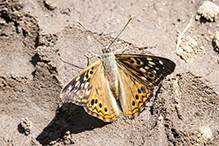 |
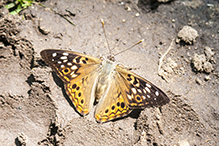 |
|
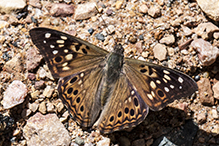 |
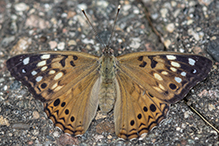 |
|
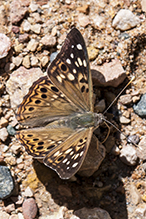 |
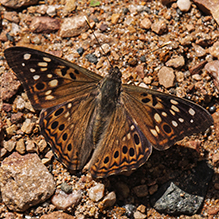 |
|
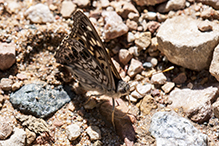 |
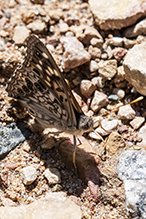 |

Visitor Videos |
||
Share your video of this insect. |
||
This button not working for you? |
||
|
Other Videos |
||
Hackberry Emperor (Nymphalidae: Asterocampa celtis) Showing Proboscis |
About
Uploaded on Jul 23, 2009 Photographed near Mekinock, North Dakota (23 July 2009). |
Hackberry Emperor feeding on dung |
About
Uploaded on Jun 12, 2011 Hackberry Emperor ( Asterocampa celtis ) feeding on dung. Unlike the popular image of butterfly and flowers some butterflies actually eat dung and carrion. |
Hackberry Emperor (Nymphalidae: Asterocampa celtis) on Ground |
About
Uploaded on Jul 23, 2009 Photographed near Mekinock, North Dakota (23 July 2009). "For years and years I struggled / just to love my life. And then / the butterfly / rose, weightless, in the wind. / 'Don't love your life / too much,' it said, / and vanished / into the world." --Mary Oliver |
Hackberry Emperor (Asterocampa celtis) |
About
Uploaded on Jun 12, 2011 Hackberry Emperor (Asterocampa celtis) eating dung |
Getting eggs out of hackberry butterfly females |
About
Uploaded on Jun 6, 2010 Demonstration of getting eggs out of Asterocampa celtis celtis females using a screen cage. Females in the wild lay on host with newer growth. |

Visitor Sightings |
||
Report a sighting of this insect. |
||
This button not working for you? |
||
| Greg Watson 6/14/2021 |
Location: in my backyard in La Crescent, MN. Plenty of these flying around today, even landing on me. They seemed to be probing for salts on me as well as on rocks. |
MinnesotaSeasons.com Sightings |
||

Created: 6/28/2015 Last Updated: © MinnesotaSeasons.com. All rights reserved. |
